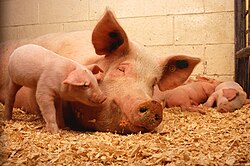This is an old revision of this page, as edited by Barbara Shack (talk | contribs) at 15:10, 10 March 2006 (→As food). The present address (URL) is a permanent link to this revision, which may differ significantly from the current revision.
Revision as of 15:10, 10 March 2006 by Barbara Shack (talk | contribs) (→As food)(diff) ← Previous revision | Latest revision (diff) | Newer revision → (diff)
| Domestic Pig | |
|---|---|

| |
| Sow and five piglets | |
| Conservation status | |
| Template:StatusDomesticated | |
| Scientific classification | |
| Kingdom: | Animalia |
| Phylum: | Chordata |
| Class: | Mammalia |
| Order: | Artiodactyla |
| Family: | Suidae |
| Genus: | Sus |
| Species: | S. scrofa |
| Binomial name | |
| Sus scrofa Linnaeus, 1758 | |
| Synonyms | |
|
Sus domesticus | |
The domestic pig (Sus scrofa domesticus) is usually given the scientific name Sus scrofa, though some authors call it S. domesticus, reserving S. scrofa for the wild boar. It was domesticated approximately 5,000 to 7,000 years ago. Pigs are found across Europe, the Middle East and extend into Asia as far as Indonesia and Japan. The distinction between wild and domestic animals is slight, and domestic pigs have become feral in many parts of the world (for example, New Zealand) and caused substantial environmental damage.
Sus scrofa has four subspecies, each occupying distinct geographical areas:
- Sus scrofa scrofa (western Africa, Europe)
- Sus scrofa ussuricus (northern Asia and Japan)
- Sus scrofa cristatus (Asia Minor, India)
- Sus scrofa vittatus (Indonesia)
Pigs were brought to southeastern North America from Europe by De Soto and other early Spanish explorers. Escaped pigs became feral and were freely used by Native Americans as food.
As food

The primary use of the domestic pig is as a meat animal.
Factory Farmed Pigs
In industrialized nations, domestic pigs are raised in large-scale factory farms where the meat, called pork, can be mass-produced. Factory farmed pigs can spend their lives in and unnatural conditions, considered cruel and become “like machines producing piglets as if on an assembly line.
Sows can spend their lives forced into very small crates, deprived of fresh air, the sun and straw bedding. Pigs cannot root naturally in soft ground or forage for food naturally. Denying intelligent pigs their basic needs causes severe physical and psychological stress.
Piglets can suffer a range of mutilations without anaesthetic. They are Castrated. Their tales are docked to reduce tale biting. Pigs are highly intelligent animals. Tale biting is one of many unnatural behaviours which develop when they are kept in unstimulating factory farms. Their teeth are clipped and their ears notched to help identification. 15% of piglets die within two or three weeks of birth. Surviving piglets are removed from their mothers and crowded together in sheds of metal and concrete. The National Hog Farmer magazine advises, "Crowding Pigs Pays...".
Many of the pork products purchased in supermarkets and restaurants come from these types of farms.
Extensively Farmed Pigs

However, in developing nations and rural areas of developed nations, the domestic pig is frequently raised in a traditional farmyard setting. In some cases pigs are even raised in open fields where they are allowed to forage; they are watched by swineherds, essentially shepherds for pigs.
Popular food products made of pork include sausage, bacon, ham, pig knuckles, etc. The head of a pig can be used to make head cheese. Liver, chitterlings, and other offal from pigs are also widely used for food, although their consumption is less common in certain countries, including United States.
In certain religions, especially Judaism and Islam, eating the meat of pigs is forbidden.
As pets
Pigs are known to be intelligent animals and have been found to be more trainable than dogs or cats. Asian pot-bellied pigs, a smaller subspecies of the domestic pig, have made popular house pets in the United States beginning in the latter half of the 20th century. Regular domestic farmyard pigs have also been known to be kept indoors, but due to their large size and destructive tendancies, they typically need to be moved into an outdoor pen as they grow older.
Breeds of pigs

Breeds within the UK
In the UK, pig breeds are generally classified into two groups:
- Traditional
- Berkshire
- Hampshire
- Large Black
- Large White
- Middle White
- Tamworth
- Wessex Saddleback
- Chester White
- Gloucestershire Old Spots
- Oxford Sandy and Black
- British Lop
- Welsh
- Modern
- Duroc
- Landrace
Breeds outside the UK
Pig breeds outside the UK include:
- Zungo
- Yanan
- West French White
- Vietnamese Potbelly
- Spotted
- Red Wattle
- Norwegian Yorkshire
- Kune-Kune (pronounced "koonee-koonee")